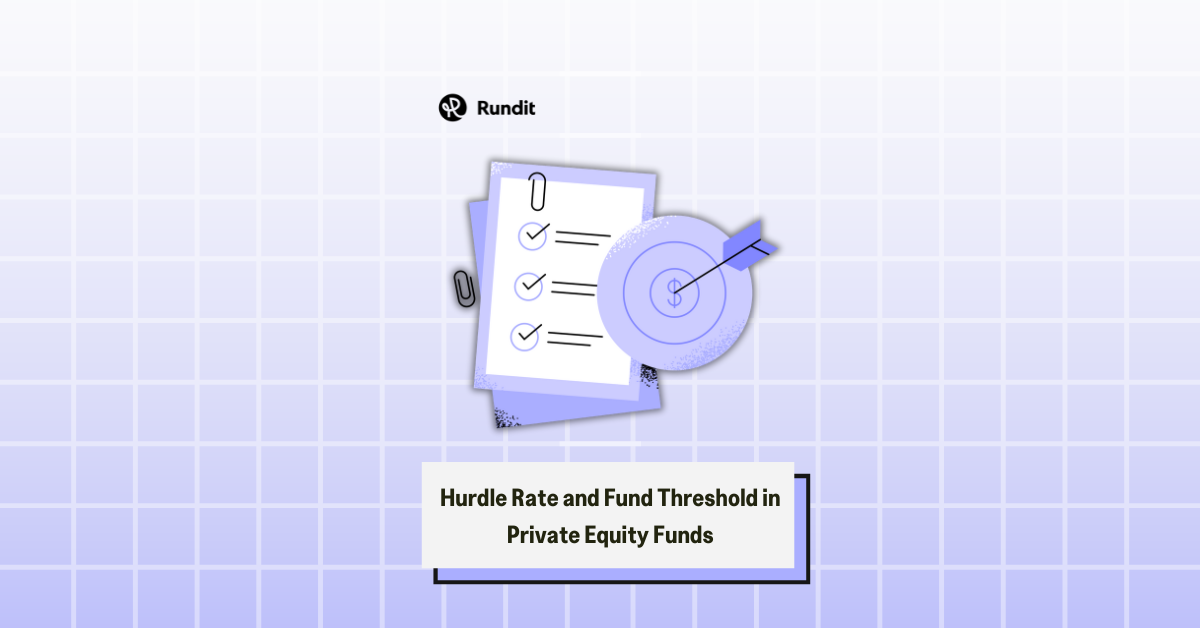
Private equity (PE) funds are highly structured investment vehicles, and for investors and fund managers alike, two key performance benchmarks often come into play: the hurdle rate and the fund threshold. These terms are central to how profits are distributed between limited partners (LPs)—the investors—and general partners (GPs)—the managers of the fund. This blog will break down these concepts and explain their role in the broader PE landscape.
Understanding these terms is essential for anyone involved in the private equity space, as they influence not only profit-sharing but also the alignment of interests between GPs and LPs. The hurdle rate acts as a minimum return target that must be achieved before fund managers can receive a share of the profits, while the fund threshold ensures that investors are prioritized in receiving their returns before GPs benefit.
The hurdle rate represents the minimum return that a private equity fund must achieve before GPs are entitled to carried interest. Carried interest (often referred to as “carry”) is a portion of the fund’s profits—typically 20%—that the GPs receive as compensation for generating high returns.
The hurdle rate serves as a form of investor protection, ensuring that the GPs only receive a performance-based payout if the fund meets or exceeds a pre-set benchmark. This motivates GPs to seek above-market returns to unlock their share of the profits.
Hurdle rates come in two common varieties: hard and soft.
1. Hard Hurdle Rate:
In a hard hurdle, carried interest is only calculated on the profits that exceed the hurdle rate. For example, if the hurdle rate is set at 8% and the fund generates a 12% return, the GP’s carried interest would only apply to the 4% that exceeds the 8% hurdle rate.
2. Soft Hurdle Rate:
In contrast, with a soft hurdle, once the fund surpasses the hurdle rate, carried interest is calculated on the entire profit, not just the amount over the hurdle rate. So, if the hurdle rate is 8% and the fund achieves a 12% return, the carry is applied to the full 12%.
Example:
If a fund has an 8% hurdle rate and generates a 12% return:
– Hard hurdle: The carry applies to the 4% above the 8%.
– Soft hurdle: The carry applies to the entire 12% return.
The fund threshold is a closely related concept, though it refers more broadly to the minimum acceptable performance for the fund. In private equity, the fund threshold often sets the baseline for distributions to LPs before GPs can receive carried interest.
While the hurdle rate acts as a trigger for carried interest, the fund threshold ensures that investors have their capital returned (along with a reasonable preferred return) before GPs participate in the profits. This threshold is typically aligned with the hurdle rate, but it emphasizes the order in which proceeds are distributed rather than a benchmark for profit-sharing.
Subscribe to our newsletter
Sign up to receive our newsletter for exclusive updates, insights, and exciting news delivered straight to your inbox.
Both the hurdle rate and fund threshold ensure that investors, primarily LPs, are prioritized in receiving their returns before GPs receive any performance-based compensation. This alignment of interests encourages GPs to pursue high-quality investment opportunities and protect the capital of LPs.
Here’s a breakdown of the relationship:
1. LPs’ Priority: First, LPs receive their initial capital back from the fund.
2. Hurdle Rate: Once the initial capital is returned, the fund must achieve the hurdle rate (e.g., 8% annualized returns) before the GPs are eligible for carried interest.
3. Excess Returns: If the hurdle rate is met, the GPs earn a share of the profits through carried interest (typically 20%).
By setting these standards, the fund ensures that LPs receive their preferred returns before profits are shared with GPs.
Hurdle rates are often tied to prevailing market conditions, and while there is no universal standard, they typically range between 6% and 10%. This range reflects the expected return for LPs in private equity relative to other investment opportunities such as public equities or bonds, which generally carry less risk but also offer lower potential returns.
The hurdle rate and fund threshold act as safety nets for LPs. They reduce the possibility that GPs receive carried interest despite suboptimal performance. For example, if a fund has a hurdle rate of 8% and returns only 6%, the GPs will not be entitled to carry under most circumstances, ensuring that LPs are compensated more fairly for the risk they have taken on.
In private equity, the hurdle rate and fund threshold are key components in aligning the interests of investors and fund managers. These mechanisms ensure that GPs are incentivized to generate robust returns while offering LPs a level of protection on their investments. By understanding how these performance benchmarks work, investors can make more informed decisions when choosing to allocate capital to private equity funds. With tools like Rundit, GPs can streamline reporting, track fund performance more effectively, and ensure transparency for their LPs, helping both parties stay aligned with these critical benchmarks. Book a call with our team to learn more!
Additional sources:
1. Investopedia – Hurdle Rate Definition 🔗
2. Preqin – Private Equity Fund Structures 🔗
3. PWC – Carried Interest in Private Equity 🔗